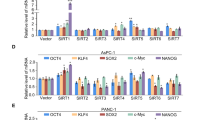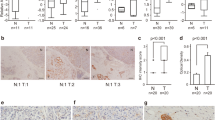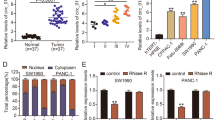Abstract
The NAD+-dependent deacetylase, sirtuin 1 (SIRT1), has been recently been suspected to have a role in tumorigenesis. We investigated the expression of SIRT1 in pancreatic cancer and the effect of SIRT1-targeted RNA interference (RNAi) on cell proliferation and tumor formation in a pancreatic cancer cell line, PANC1. The expression of SIRT1 was investigated in 49 specimens of pancreatic cancer and adjacent normal pancreatic tissues. SIRT1 was overexpressed in pancreatic cancer tissues at both the mRNA and protein levels, with increased SIRT1 positivity associated with tumors from patients over 60 years old, tumors larger than 4 cm, higher TNM (extent of tumor (T), the extent of spread to lymph nodes (N), and presence of distant metastasis (M)) stage or the presence of lymph node or hepatic metastases. The PANC-1 was stably transfected with a SIRT1 small hairpin RNA (shRNA) expression plasmid and compared with untransfected and PANC-1-negative RNAi cells. Proliferation of PANC-1–SIRT1–RNAi cells was significantly reduced, accompanied by increased rates of apoptosis, G1 arrest and senescence. Furthermore, FOXO3a expression was markedly upregulated in PANC-1–SIRT1–RNAi cells, but no significant difference in p53 expression was observed. The invasive ability of PANC-1–SIRT1–RNAi cells was markedly reduced in vitro, which was linked to increased E-cadherin and reduced-MMP expression. Additionally, PANC-1–SIRT1–RNAi cells had a significantly reduced capacity to form tumors in vivo compared with untransfected and PANC-1-negative RNAi cells. These results suggest that SIRT1 may promote cell proliferation and tumor formation in pancreatic cancer, and downregulation of SIRT1 using shRNA could provide a novel therapeutic treatment.
This is a preview of subscription content, access via your institution
Access options
Subscribe to this journal
Receive 12 print issues and online access
$259.00 per year
only $21.58 per issue
Buy this article
- Purchase on Springer Link
- Instant access to full article PDF
Prices may be subject to local taxes which are calculated during checkout





Similar content being viewed by others
References
Jemal A, Siegel R, Ward E, Hao Y, Xu J, Murray T et al. Cancer statistics, 2008. CA Cancer J Clin 2008; 58: 71–96.
Keleg S, Buchler P, Ludwig R, Buchler MW, Friess H . Invasion and metastasis in pancreatic cancer. Mol Cancer 2003; 2: 14.
Zhao YP, Chen G, Feng B, Zhang TP, Ma EL, Wu YD . Microarray analysis of gene expression profile of multidrug resistance in pancreatic cancer. Chin Med J (Engl) 2007; 120: 1743–1752.
Glozak MA, Seto E . Histone deacetylases and cancer. Oncogene 2007; 26: 5420–5432.
Saunders LR, Verdin E . Sirtuins: critical regulators at the crossroads between cancer and aging. Oncogene 2007; 26: 5489–5504.
McBurney MW, Yang X, Jardine K, Bieman M, Th’ng J, Lemieux M . The absence of SIR2alpha protein has no effect on global gene silencing in mouse embryonic stem cells. Mol Cancer Res 2003; 1: 402–409.
Denu JM . The Sir 2 family of protein deacetylases. Curr Opin Chem Biol 2005; 9: 431–440.
Hisahara S, Chiba S, Matsumoto H, Horio Y . Transcriptional regulation of neuronal genes and its effect on neural functions: NAD-dependent histone deacetylase SIRT1 (Sir2alpha). J Pharmacol Sci 2005; 98: 200–204.
Guarente L . Sirtuins as potential targets for metabolic syndrome. Nature 2006; 444: 868–874.
Haigis MC, Guarente LP . Mammalian sirtuins—emerging roles in physiology, aging, and calorie restriction. Genes Dev 2006; 20: 2913–2921.
Vaziri H, Dessain SK, Ng EE, Imai SI, Frye RA, Pandita TK et al. hSIR2(SIRT1) functions as an NAD-dependent p53 deacetylase. Cell 2001; 107: 149–159.
Brunet A, Sweeney LB, Sturgill JF, Chua KF, Greer PL, Lin Y et al. Stress-dependent regulation of FOXO transcription factors by the SIRT1 deacetylase. Science 2004; 303: 2011–2015.
Motta MC, Divecha N, Lemieux M, Kamel C, Chen D, Gu W et al. Mammalian SIRT1 represses forkhead transcription factors. Cell 2004; 116: 551–563.
Michan S, Sinclair D . Sirtuins in mammals: insights into their biological function. Biochem J 2007; 404: 1–13.
Qiao AM, Ikejima T, Tashiro S, Onodera S, Zhang WG, Wu YL . Involvement of mitochondria and caspase pathways in N-demethyl-clarithromycin-induced apoptosis in human cervical cancer HeLa cell. Acta Pharmacol Sin 2006; 27: 1622–1629.
Cohen HY, Miller C, Bitterman KJ, Wall NR, Hekking B, Kessler B et al. Calorie restriction promotes mammalian cell survival by inducing the SIRT1 deacetylase. Science 2004; 305: 390–392.
Jones PA, Baylin SB . The fundamental role of epigenetic events in cancer. Nat Rev Genet 2002; 3: 415–428.
Huffman DM, Grizzle WE, Bamman MM, Kim JS, Eltoum IA, Elgavish A et al. SIRT1 is significantly elevated in mouse and human prostate cancer. Cancer Res 2007; 67: 6612–6618.
Bradbury CA, Khanim FL, Hayden R, Bunce CM, White DA, Drayson MT et al. Histone deacetylases in acute myeloid leukaemia show a distinctive pattern of expression that changes selectively in response to deacetylase inhibitors. Leukemia 2005; 19: 1751–1759.
Stunkel W, Peh BK, Tan YC, Nayagam VM, Wang X, Salto-Tellez M et al. Function of the SIRT1 protein deacetylase in cancer. Biotechnol J 2007; 2: 1360–1368.
Bourguignon LY, Xia W, Wong G . Hyaluronan-mediated CD44 interaction with p300 and SIRT1 regulates beta-catenin signaling and NFkappaB-specific transcription activity leading to MDR1 and Bcl-xL gene expression and chemoresistance in breast tumor cells. J Biol Chem 2009; 284: 2657–2671.
Tryndyak VP, Beland FA, Pogribny IP . E-cadherin transcriptional down-regulation by epigenetic and microRNA-200 family alterations is related to mesenchymal and drug-resistant phenotypes in human breast cancer cells. Int J Cancer 2010; 126: 2575–2583.
Kim JH, Park JM, Jung CW, Park SS, Kim SJ, Mok YJ et al. The significances of lymph node micrometastasis and its correlation with E-cadherin expression in pT1-T3N0 gastric adenocarcinoma. J Surg Oncol 2008; 97: 125–130.
Chu F, Chou PM, Zheng X, Mirkin BL, Rebbaa A . Control of multidrug resistance gene mdr1 and cancer resistance to chemotherapy by the longevity gene sirt1. Cancer Res 2005; 65: 10183–10187.
Lim CS . SIRT1: tumor promoter or tumor suppressor? Med Hypotheses 2006; 67: 341–344.
Kabra N, Li Z, Chen L, Li B, Zhang X, Wang C et al. SirT1 is an inhibitor of proliferation and tumor formation in colon cancer. J Biol Chem 2009; 284: 18210–18217.
Herranz D, Muñoz-Martin M, Cañamero M, Mulero F, Martinez-Pastor B, Fernandez-Capetillo O et al. Sirt1 improves healthy ageing and protects from metabolic syndrome-associated cancer. Nat Commun 2010; 1: 1–8.
Jung-Hynes B, Ahmad N . Role of p53 in the anti-proliferative effects of Sirt1 inhibition in prostate cancer cells. Cell Cycle 2009; 8: 1478–1483.
Ford J, Jiang M, Milner J . Cancer-specific functions of SIRT1 enable human epithelial cancer cell growth and survival. Cancer Res 2005; 65: 10457–10463.
Ota H, Tokunaga E, Chang K, Hikasa M, Iijima K, Eto M et al. Sirt1 inhibitor, Sirtinol, induces senescence-like growth arrest with attenuated Ras-MAPK signaling in human cancer cells. Oncogene 2006; 25: 176–185.
Wey JS, Gray MJ, Fan F, Belcheva A, McCarty MF, Stoeltzing O et al. Overexpression of neuropilin-1 promotes constitutive MAPK signalling and chemoresistance in pancreatic cancer cells. Br J Cancer 2005; 93: 233–241.
Ouaïssi M, Sielezneff I, Silvestre R, Sastre B, Bernard JP, Lafontaine JS et al. High histone deacetylase 7 (HDAC7) expression is significantly associated with adenocarcinomas of the pancreas. Ann Surg Oncol 2008; 15: 2318–2328.
Jang KY, Hwang SH, Kwon KS, Kim KR, Choi HN, Lee NR et al. SIRT1 expression is associated with poor prognosis of diffuse large B-cell lymphoma. Am J Surg Pathol 2008; 32: 1523–1531.
Lee H, Kim KR, Noh SJ, Park HS, Kwon KS, Park BH et al. Expression of DBC1 and SIRT1 is associated with poor prognosis for breast carcinoma. Hum Pathol 2011; 42: 204–213.
Cha EJ, Noh SJ, Kwon KS, Kim CY, Park BH, Park HS et al. Expression of DBC1 and SIRT1 is associated with poor prognosis of gastric carcinoma. Clin Cancer Res 2009; 15: 4453–4459.
Nosho K, Shima K, Irahara N, Kure S, Firestein R, Baba Y et al. SIRT1 histone deacetylase expression is associated with microsatellite instability and CpG island methylator phenotype in colorectal cancer. Mod Pathol 2009; 22: 922–932.
Jang KY, Kim KS, Hwang SH, Kwon KS, Kim KR, Park HS et al. Expression and prognostic significance of SIRT1 in ovarian epithelial tumours. Pathology 2009; 41: 366–371.
Heltweg B, Gatbonton T, Schuler AD, Posakony J, Li H, Goehle S et al. Antitumor activity of a small-molecule inhibitor of human silent information regulator 2 enzymes. Cancer Res 2006; 66: 4368–4377.
Jung-Hynes B, Nihal M, Zhong W, Ahmad N . Role of sirtuin histone deacetylase SIRT1 in prostate cancer. A target for prostate cancer management via its inhibition? J Biol Chem 2009; 284: 3823–3832.
Ford J, Jiang M, Milner J . Cancer-specific functions of SIRT1 enable human epithelial cancer cell growth and survival. Cancer Res 2005; 65: 10457–10463.
Bihani T, Mason DX, Jackson TJ, Chen SC, Boettner B, Lin AW . Differential oncogenic Ras signaling and senescence in tumor cells. Cell Cycle 2004; 3: 1201–1207.
Mahmud DL, Amlak M, Deb DK, Platanias LC, Uddin S, Wickrema A . Phosphorylation of forkhead transcription factors by erythropoietin and stem cell factor prevents acetylation and their interaction with coactivator p300 in erythroid progenitor cells. Oncogene 2002; 21: 1556–1562.
Levine AJ . p53, the cellular gatekeeper for growth and division. Cell 1997; 88: 323–331.
Reed JC . Double identity for proteins of the Bcl-2 family. Nature 1997; 387: 773–776.
Li Y, Yokota T, Gama V, Yoshida T, Gomez JA, Ishikawa K et al. Bax-inhibiting peptide protects cells from polyglutamine toxicity caused by Ku70 acetylation. Cell Death Differ 2007; 14: 2058–2067.
Van Der Heide LP, Hoekman MF, Smidt MP . The ins and outs of FoxO shuttling: mechanisms of FoxO translocation and transcriptional regulation. Biochem J 2004; 380 (Part 2): 297–309.
Kobayashi D, Sasaki M, Watanabe N . Caspase-3 activation downstream from reactive oxygen species in heat-induced apoptosis of pancreatic carcinoma cells carrying a mutant p53 gene. Pancreas 2001; 22: 255–260.
Kurz DJ, Decary S, Hong Y, Erusalimsky JD . Senescence-associated (beta)-galactosidase reflects an increase in lysosomal mass during replicative ageing of human endothelial cells. J Cell Sci 2000; 113 (Part 20): 3613–3622.
Dimri GP, Lee X, Basile G, Acosta M, Scott G, Roskelley C et al. A biomarker that identifies senescent human cells in culture and in aging skin in vivo. Proc Natl Acad Sci USA 1995; 92: 9363–9367.
Tsutsumi S, Yanagawa T, Shimura T, Kuwano H, Raz A . Autocrine motility factor signaling enhances pancreatic cancer metastasis. Clin Cancer Res 2004; 10: 7775–7784.
Livak KJ, Schmittgen TD . Analysis of relative gene expression data using real-time quantitative PCR and the 2(-Delta Delta C(T)) Method. Methods 2001; 25: 402–408.
Kabra N, Li Z, Chen L, Li B, Zhang X, Wang C et al. SirT1 is an inhibitor of proliferation and tumor formation in colon cancer. J Biol Chem 2009; 284: 18210–18217.
Acknowledgements
This study was funded by grants from the National Science Foundation Committee (NSFC) of China (Grant number: 30600594 and 30972900). Grant sponsor: National Natural Science Foundation of China; Grant number 30600594 and 30972900.
Author information
Authors and Affiliations
Corresponding authors
Ethics declarations
Competing interests
The authors declare no conflict of interest.
Additional information
Supplementary Information accompanies the paper on Gene Therapy website
Rights and permissions
About this article
Cite this article
Zhao, G., Cui, J., Zhang, JG. et al. SIRT1 RNAi knockdown induces apoptosis and senescence, inhibits invasion and enhances chemosensitivity in pancreatic cancer cells. Gene Ther 18, 920–928 (2011). https://doi.org/10.1038/gt.2011.81
Received:
Revised:
Accepted:
Published:
Issue Date:
DOI: https://doi.org/10.1038/gt.2011.81
Keywords
This article is cited by
-
SIRT1 upregulation promotes epithelial-mesenchymal transition by inducing senescence escape in endometriosis
Scientific Reports (2022)
-
SIRT1 coordinates with the CRL4B complex to regulate pancreatic cancer stem cells to promote tumorigenesis
Cell Death & Differentiation (2021)
-
SYT8 promotes pancreatic cancer progression via the TNNI2/ERRα/SIRT1 signaling pathway
Cell Death Discovery (2021)
-
Integrative data modeling from lung and lymphatic cancer predicts functional roles for miR-34a and miR-16 in cell fate regulation
Scientific Reports (2020)
-
ZEB2 stably represses RAB25 expression through epigenetic regulation by SIRT1 and DNMTs during epithelial-to-mesenchymal transition
Epigenetics & Chromatin (2018)



